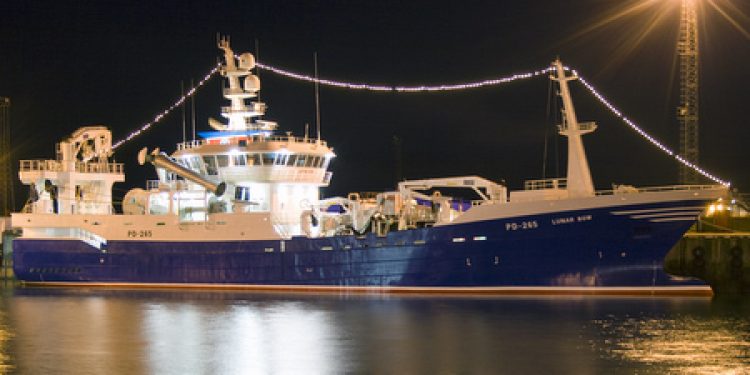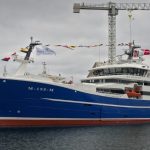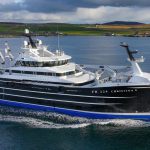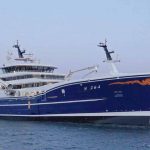Lunar Fishing Co. Ltd. of Peterhead, Scotland, takes delivery of M/V “Lunar Bow” from Simek A/S. “Lunar Bow” is the 15th vessel delivered from Simek AS to Lunar Fishing Co. Ltd. over the years. The first one was yard No. 13, “Lunar Bow” in August 1970, of 26,45 m. Today’s vessel is the sixth vessel with the same name from Simek A/S, and compared with the first one, gives the developments in fisheries over the years. “Lunar Bow” has an over all length of 69,30 m (227ft 4ins), beam of 14,50 m (47ft 7 ins), depth to shelterdeck of 9,00 m (29ft 6ins) and a loaded draught of 7,25 m (23ft 9,4ins).
The vessel will be skippered by Alexander Buchan jr., son of Alexander Buchan, one of the directors of the family-owned company. “Lunar Bow” will be one of two pelagic vessels operated by the company, catching herring and mackerel during the seasons and other pelagic spices like horse mackerel, capelin and blue whiting in the off-season periods.
“Lunar Bow” is of a traditional Purse Seiner/Trawler design, and Lunar Fishing is still building their vessels as combined Purse Seiner/Trawlers though most of the new pelagic vessels are Pelagic Trawlers only. The vessel is of an all-welded construction with bulbous bow, transom stern, and a full shelterdeck. Designed with a deep bilge she has a good sea-keeping capability together with high carrying capacity and speed.
The vessel is designed by the yard in close co-operation with the owners, incorporating ideas and innovations of the skipper. Vik-Sandvik AS of Fitjar, Norway, have designed the hull, and done the calculations of the vessel.
“Lunar Bow’s” carrying capacity in the twelve fish tanks is between 1400 and 2000 tonnes, depending on the species and the ratio of fish to water in the RSW tanks of 1950 m3. Fuel capacity is approx. 663 m3. Water ballast 154 m3 and fresh water 112 m3.
The main engine is of Wärtsilä make, type 12V32, a 12 cylinder V-engine developing 6000 kW @ 750 RPM through a Wärtsilä SCV 95-PT116 two-step gearbox reducing the propeller revolutions. The four bladed propeller is running in a nozzle with diameter of 3,8 meter. Connected to the gearbox is a shaft generator of 3000 kW at 1200 RPM and 2500 kW at the second step of 1000 RPM. The shaft generator is the vessels main electric supply. A Caterpillar generator set, Cat 3508B, of 910 kW, producing electricity for the general use, when the main engine is shut of and in port. The generator can also supply power to the electric driven hydraulic winch pumps.
Forward under the forecastle is situated another Caterpillar. A Cat 3406C harbour and emergency generator of 260 kW. Operating the generator set forward in harbour when the power consumption is low makes the accommodation a quiet place for the crew.
To reduce the noise and vibrations from the engine, onboard and the noise out of the vessel, the engine is mounted on rubber pads. This gives a more silent vessel, both for the crew and the surrounding environment.
CHARACTERISTICS :
Length 69.4 [m]
Length between PP 59.9 [m]
Breadth moulded 14.7 [m]
Depth 7.25 [m]
Trail Speed 16 [kn]
For steering, the vessel is fitted out with a streamlined rudder operated by an Ulstein Tenfjord steering gear, and two Brunvoll side-thrusters, one forward and one aft each of 910 hp giving excellent manoeuvring in harbours and keeps the fishing gear clear of the ships side and the propeller.
Karmøy Winch AS of Koppervik, Norway, has supplied the deck machinery, winches and cranes together with the electric driven hydraulic power units for the equipment.
Forward on the forecastle deck is the anchor winch with two mooring drums.
Two off purse seine winches are situated midship on shelter-deck with 40 tonnes pull. From the winches, the wires are guided overboard via blocks on the two purse gallows.
The purse net is taken onboard on starboard side by the Tristar power block, which have a pull of 24 tonne. The Tristar feeds the net aft to the net bin via a chute and a transport roller, where the netstacker-crane lays the net automatic according to a pre-set procedure. In addition to the roller, the netstacker-crane is fitted our with a 5 tonnes winch for handling equipment aft together with the trawl doors and other trawl equipment supplied by Egersund Trawl AS.
On shelter deck forward is the main deck crane of 4 tonne at 14,5 m arm for handling deck equipment and the big 24″ fish-pump, pumping the fish onboard. Next to the crane on starboard side is a 3 tonne capstan.
About midship on shelter deck, is the fish pump crane of 2,5 tonne at 9,0 metre arm, handling the 18″ fish pump. Two hose reels, one for the hydraulic hosed to the fish pumps and one for the fish hose for pumping the fish onboard are on starboard side midship.
Forward of the superstructure is a 5,5 tonne endwire winch in centre.
Pathway have been fitted out with the Karmøy 24″ fishpump, which together with the 18″ fishpump will be used to pump the fish onboard to the strainer, where it will be sorted to the different fish tank onboard. Here the fish will be kept in refrigerated sea water with a temperature of approx. -2=616;C, which is the best temperature to keep the fish as fresh as possible until delivery ashore. When the fish is to be pumped ashore, this will be carried out using one or both of the two MMC Tendos type OVS-2500 vacuum pumps, powered by three compressors, thus providing two complete systems and still have one compressor for back-up facilities. The MMC Tendos vacuum pump unit can discharge herring at a rate of 150 – 170 tonnes per hour and mackerel at around 150 tonnes an hour, a big difference compared to the old brailing method when delivering the fish ashore.
The RSW system supplied by Tecnotherm AS, Norway, arranged in two separate systems, each of 855.000 Kcal/h capacity, running on Amonia. The two systems can operate separately or be used as one common system. The RSW plants itself are locally operated, but the cooling process and distribution of water is remote controlled from bridge, Engine Control Room and below forecastle deck with an Ulstein Automation AS (Rolls-Royce Marine AS) of Longva, Norway supplied system. It is an advanced system, where the skipper can sit up on the bridge and have full control of the RSW distribution system via his computer screen, checking temperature and opening and closing valves according to size of catch and temperature in the tanks. Before you needed a separate man to run to and from the forward part of the vessel opening and closing the valves.
Aft on shelter- and boat-deck are the two netdrums on port side, each with 50 tonnes pull and 30 m3 drum capacity. With the two netdrums, two different trawls can be accommodated onboard at the same time, and this allows the trawls to be worked alternatively. Above the netdrums is the netsounding winch, through its cable, the trawl performance details are transferred to monitors in the wheelhouse, giving data about the opening, depth etc. of the trawl in the sea.
Forward of the net drums on boat deck are the two trawl winches, one each side and the toppline winch in centre. The trawl winches have a pull of 82 tonnes with automatic spooling gear of the wire. The topline winch has a pull of 50 tonne. Scan Rope of Tønsberg, Norway, has supplied all fishing wires onboard and the vessel is ready to go fishing. A mooring winch of 4,4 tonne pull is situated aft on boat deck in centre
On starboard side of the boat-deck is a 50 tonne top-line winch, with a 36 tonne Midline Winch of 14 m3 capacity. Forward of the superstructure is the end-wire winch on a shelf at boat-deck level in centre. At port side is the fish pump crane, used when they are lowering the 14″ fish pump down into the purse-net, pumping the fish onboard via the drainer on deck down to the chilled fish tanks.
The accommodation onboard is for a total crew of 18 men, but all the beds are seldom used. Normally they are fishing with 9 men when trawling and 11 men when purse seining. Master and mate are living on boat-deck in their own cabins with separate WC/shower, just below the wheelhouse. Here is also the vessels hospital.
Galley with mess and dayrooms are arranged on shelter-deck together with dry provision, freeze/cool rooms and drying / change room for the crew. Special attention have been taken to make the day rooms as pleasant as possible for the crew, because it is here they spend the time when they are not busy fishing. The dayrooms are fitted out with modern easy chairs and sofas, thinking of the crew’s welfare, and taking into consideration that they have their second home onboard.
The whole accommodation is designed and built to a high standard of materials and workmanship.
Below on the main-deck are 10 cabins, all with separate WC/shower, 6 off single cabins, 3 off 2 men cabins and one 4 men cabin. The ships laundry is also on main deck
The furniture onboard is made to the yards design and standards, except for the chairs and sofas. The yards own carpenters, have made the accommodation, with wall panels of Akerpanel from Norac AS and the ceiling of Danacoustic type from Hydro Aluminium.
LUNAR BOW landing her first catch in Peterhead, after only 48 hours fishing. 1.100 tons of mackerel, to the value of 1 million Euros. The old LUNAR BOW is now the “Asgrimur Halldorsson” SF250 homeport in Hornafjordur, Iceland
The wheelhouse is spacious with a compact layout of equipment, arranged with necessary navigation equipment for sailing the vessel in addition to all the fish-finding equipment necessary onboard a new fishing vessel being installed forward. All the electronic equipment onboard has been supplied by Woodsons of Aberdeen. Forward in on starboard is an U-formed console, with 2 off skippers chairs, here the skipper have full control of the vessel. The radio equipment is situated in overhead panels in the deck head, in easy reach from the chairs. Starboard part of the console has the main steering position with engine and propeller controls, together with steering and thruster levers. Here is also the purse seine position, overlooking the starboard side of the vessel with control of the purse winches and the power block On port side is a slave steering position, and at the rear of the wheelhouse is the main winch control station which gives a good view of the aft deck with the trawl winches, net drums and the net bin.
“Lunar Bow”, will together with the other vessel in the Lunar Fishing fleet, mainly land their catch at their own freezing plant in Peterhead, but also to other ports in the UK or abroad (mainly Norway and Denmark).









